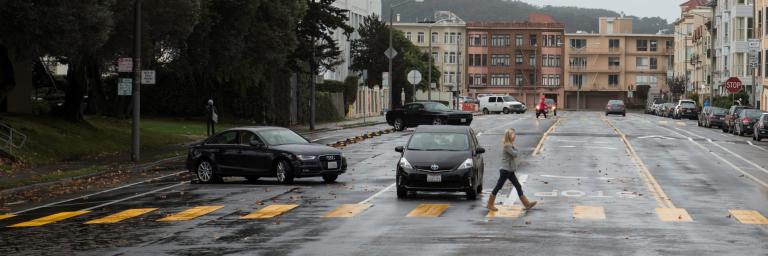The Bay Street Road Diet and Cycletrack project has been completed. The project goal was to improve the safety and comfort of Bay Street between Fillmore and Laguna streets for all roadway users by reducing vehicle speeds.
The Bay Street Road Diet and Cycletrack project was one part of a comprehensive upgrade of the Bay Street corridor. This was a citywide effort that involves several city agencies. The first phase of the work, which included upgrading sewer lines and installing new curb ramps in the area, was completed October 2015. The repaving work was completed November 2015. SFMTA installed the upgrades to slow traffic in the area by reducing a lane of traffic and adding a speed hump that same November.
- Completed
While Bay Street has a posted speed limit of 25 MPH, the surrounding community has noted that high vehicle speeds are prevalent, and that there is a need for safety and traffic calming measures.
Traffic analysis conducted by the SFMTA confirmed these observations, finding that on the segment of Bay Street between Laguna and Fillmore streets, the majority of westbound motor vehicles travelled at 33.2 MPH and the majority of eastbound motor vehicles travelled at 34.3 MPH.
INSTALLED MEASURES
To slow vehicle speeds on this segment of Bay Street and to create a more safe, comfortable travel experience for all road users, the SFMTA installed a “road diet” which reduced Bay Street from two travel lanes in each direction to one travel lane in each direction between Fillmore and Laguna Streets.
Westbound Bay Street was reconfigured to include one traffic lane, a bicycle lane with a painted buffer, and a parking lane. The center turn lane remained part of the new configuration.
In the eastbound direction, Bay Street was reconfigured to include one traffic lane, a back-in angled parking lane, a painted buffer, and a bicycle lane. The eastbound bicycle lane was moved to be adjacent to the curb with a painted buffer space between the bikeway and the back-in angled parking lane.
This design was selected because it narrows the roadway, which reduces speeding and improves pedestrian safety by shortening the crossing distance at intersections. Slowing speeds and improving safety by narrowing the roadway was especially important given the nearby activity at Marina Middle School, Moscone Recreation Center and Park, Fort Mason and the assisted living facility.
This design also enhanced the bikeway, making it more comfortable for people with a variety of bicycle comfort levels by providing more separation from moving traffic.
OUTREACH
The SFMTA conducted a community outreach period that included a community meeting with local residents and informational materials mailed to nearby residents.
On September 13, 2013, an SFMTA Transportation Engineering public hearing was held where five people spoke in favor of the proposed project citing concerns with traffic speed, and the safety of people who walk and bike in the project area.
Speed hump ballots were mailed on November 22, 2013 to the fronting properties on Bay Street between Laguna Street and Webster Street. The returned ballots showed simple majority approval of the proposed speed hump.
On August 15, 2014, an SFMTA Transportation Engineering public hearing was held and there were three members of the public who commented on the proposed traffic changes. All spoke in favor of the proposed project.
